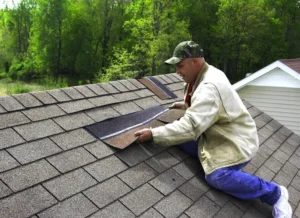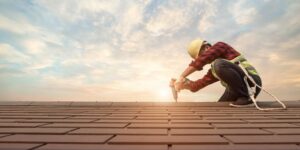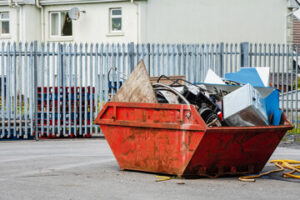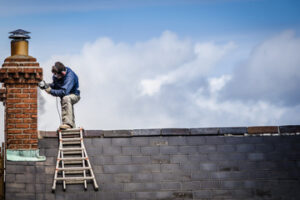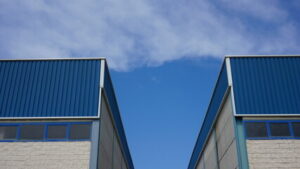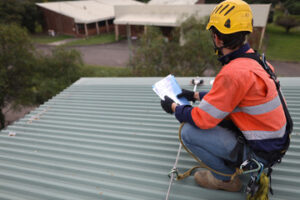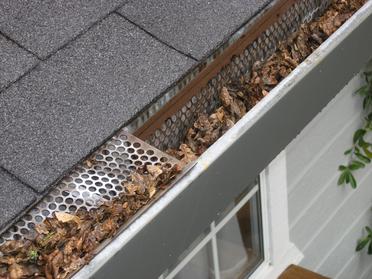Your roof is under constant attack from weather, debris, and sun. It’s important to protect it and catch problems before they become serious issues that can compromise the integrity of your home. Inspectors look for the condition of shingles, including curling or missing granules and moss, to do Roof Repair Johns Creek. They also check soffit boards and gutters and examine the condition of penetration seals on vent pipes and other roof penetrations.
Walk-Around

A professional home inspector has a special eye for problems, including those hidden within the walls and ceilings of a house. During a roof inspection, the inspector will walk outside the home and look at gutters, eaves, and soffits for damage or deterioration. This gives the inspector an idea of what they might find once they get on the roof itself, and it helps them create a plan for where to focus their attention.
The next step is to enter the attic, which allows the inspector to see if there are any issues with the insulation and roof ventilation. The inspector will also be able to identify water stains and other evidence of a leaky roof. Inspecting the attic will help the inspector determine whether a potential problem could be caused by the roof itself or by something else, such as a foundation issue.
If the attic inspection finds nothing alarming, the inspector will climb a ladder to walk on the outside of the roof. This is the most important part of the roof inspection, because it lets the inspector see how well the shingles are in place and the overall condition of the roof. In many cases, the inspector will take core samples from various points on the roof to evaluate the condition of the different layers of material. This will indicate whether the roof needs to be replaced right away or if it would hold up with some basic repairs.
While on the roof, the inspector will also examine the condition of any add-ons to the house such as skylights, chimneys, and vents. These can contribute to a leaking roof if the materials aren’t installed correctly or if they suffer from poor workmanship down the road.
Once the inspector has walked around the entire roof, they will write up their findings in a report. They will classify them according to color, with red indicating the most severe problems that need immediate attention, orange indicating common issues that can be repaired by a general contractor, and blue indicating simpler concerns that may not need any action at all.
Ladder Inspection
A recent tragedy at a roofing company highlights the importance of ladder inspections. One of the technicians was using a ladder to access a roof for a routine inspection and repair, when he felt the ladder begin to give way under him. He held on for safety and waited until another technician could set up a new ladder to continue his work. Ladders are involved in a substantial number of worker fall injuries, which makes them an important workplace risk to mitigate with thorough ladder inspections.
Ladders are not meant to be used as climbing aids, but rather to help workers get up to the right height for their jobs. To make sure ladders are safe to use, they must be inspected regularly, before and after each use. This involves a detailed visual and physical check of the entire ladder, from its feet to the top rungs. Ladders should be inspected in accordance with government regulations and best practices.
The frequency of ladder inspections depends on several factors, including how often the ladder is used, its location, exposure to unwanted environmental elements like salt air, and relevant mechanisms installed on the ladder. The inspector must consider all these factors to determine the ideal frequency of inspections.
During ladder inspections, employees should look for any components that are prone to corrosion. These components include ladder rungs, rails, fasteners, hatches, and ladder extensions, among others. Ladders that are corroded are not safe for use. Employees should also look for any other signs of damage to the ladder, such as bowed or twisted rails.
In addition to examining ladders for potential problems, employees should ensure that the ladder is correctly positioned and secured. Workers should not place blocks, boxes, or other materials under the ladder to “level” it, and they should not try to gain height on the ladder by extending beyond its intended length. If the ladder is found to be unsuitable for use, it must be tagged and put out of service, and any tools or equipment on the ladder should be removed.
Whether it is a simple or complex ladder, it is essential that every component of the ladder be checked before each use. Ladder non-compliance can lead to serious bodily injury and loss of life, as well as expensive fines for the employer. To prevent these violations, employers should familiarize themselves with the OSHA guidelines for ladders and implement them in their workplaces.
Attic Inspection
An attic inspection offers a wealth of information to combat problems like high energy bills, poor indoor air quality and mold growth. It also provides a bird’s-eye view of the roof structure and ventilation systems. According to Brian Cooper of Cooper Inspection Services, LLC, the attic inspection reveals “the quality and quantity of insulation; the presence of any moisture, mold or pests; the condition of vent stacks, ductwork and the attic hatch; and the status of the roof.”
A thorough attic inspection includes a review of the framing boards, sheathing, trusses, insulation and ventilation system. The inspector will check the quality of the insulation and ventilation, looking for signs of moisture issues, such as stains on the sheathing or trusses; water marks on the vent pipes; and matted or changed texture insulation that may indicate a buildup of mold and other contaminants. In addition, the attic inspection will check the condition of the rafters and trusses to determine if they are damaged or in need of repair, or if there are areas of over-loading or incorrect bracing.
The attic inspection should also include a visual assessment of the ductwork and vent stacks, ensuring that they are not blocked, leaning or improperly installed. If the home has a whole house fan that vents into the attic, the inspector should note this in the report.
Depending on the home’s wiring, the inspector will look for any wires that are running through the attic and ensure that they don’t have any insulation over them, which could create a fire hazard. In addition, the inspector will make sure that the recessed light fixtures are properly insulated.
An attic inspection can reveal a host of other items, such as soot on the rafters that may indicate a previous fire break out in the home; droppings, nests and chewed wiring that may be signs of rodent infestation; or tunnels and wood shavings that could indicate a termite problem. The inspector will document all observed issues in a detailed report and discuss them with the client. They may recommend a specific course of action or suggest additional evaluations and repairs.
Visual Inspection
A visual inspection is a common non-destructive testing method that examines the surface of an object to identify defects. Visual inspections are used in a variety of industries, including aerospace, power generation, chemical processing, and manufacturing. This technique uses minimal or no tools and only takes a short amount of time to perform. However, a visual inspection only looks at the surface of an item, so it is often used in tandem with other NDT methods to ensure complete and accurate results.
In order to conduct a visual inspection, the inspector needs to be qualified for the specific task. This requires rigorous training and good eyesight, as well as a thorough knowledge of the product or material being examined. In addition, the inspector must be able to read and understand the results of the visual inspection to identify defects.
The American Society for Nondestructive Testing (ASNT) has guidelines in place to help organizations establish a qualification program for visual inspections. The organization’s SNT-TC-1A document provides recommended education, experience, and training requirements for NDT personnel that perform visual inspections.
As technology continues to advance, visual inspections are becoming more automated and accessible. Maintenance professionals can now use remote cameras, drones, and specialized robots to inspect equipment that is hard to reach or housed in a hazardous area. These RVI tools can also capture images and relay them back to the team, reducing human error and improving efficiency.
Visual inspections are a crucial part of quality control and safety assurance across many industries. They are typically conducted by trained maintenance technicians and may be combined with other NDT techniques. Regulatory agencies like the FDA and OSHA set standards for inspections in specific industries and applications to ensure compliance with their regulations.
The visual inspection procedure is difficult to standardize due to its subjective nature. However, the inspection process can be outlined and documented to create a flow chart and checklist that can be made easily available to maintenance technicians and quality control managers. These documents can be incorporated into a CMMS solution like Facilio to make them easily accessible to the entire team.
